
Chapultepec, more commonly called the "Bosque de Chapultepec" in Mexico City, is one of the largest city parks in Mexico, measuring in total just over 686 hectares. Centered on a rock formation called Chapultepec Hill, one of the park's main functions is as an ecological space in Greater Mexico City. It is considered the first and most important of Mexico City's "lungs".
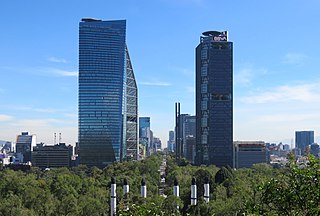
Paseo de la Reforma is a wide avenue that runs diagonally across the heart of Mexico City. It was designed at the behest of Emperor Maximilian by Ferdinand von Rosenzweig during the era of the Second Mexican Empire and modeled after the great boulevards of Europe, such as the Ringstraße in Vienna and the Champs-Élysées in Paris. The planned grand avenue was to link the National Palace with the imperial residence, Chapultepec Castle, which was then on the southwestern edge of town. The project was originally named Paseo de la Emperatriz in honor of Maximilian's consort Empress Carlota. After the fall of the Empire and Maximilian's subsequent execution, the Restored Republic renamed the Paseo in honor of the La Reforma.
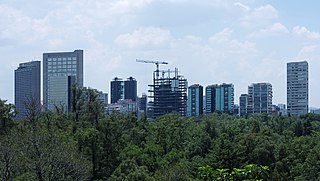
Miguel Hidalgo is a borough (alcaldía) in western Mexico City, it encompasses the historic areas of Tacuba, Chapultepec and Tacubaya along with a number of notable neighborhoods such as Polanco and Lomas de Chapultepec. With landmarks such as Chapultepec Park and the Museo Nacional de Antropología, it is the second most visited borough in Mexico City after Cuauhtémoc where the historic center of Mexico City is located. Tacubaya and Tacuba both have long histories as independent settlements and were designated as “Barrios Mágicos” by the city for tourism purposes.

Los Pinos was the official residence and office of the President of Mexico from 1934 to 2018. Located in the Bosque de Chapultepec in central Mexico City, it became the presidential seat in 1934, when Gen. Lázaro Cárdenas became the first president to live there. The term Los Pinos became a metonym for the Presidency of Mexico.

Chapultepec Castle is located on top of Chapultepec Hill in Mexico City's Chapultepec park. The name Chapultepec is the Nahuatl word chapoltepēc which means "on the hill of the grasshopper". It is located at the entrance to Chapultepec park, at a height of 2,325 metres (7,628 ft) above sea level. The site of the hill was a sacred place for Aztecs, and the buildings atop it have served several purposes during its history, including serving as a military academy, imperial residence, presidential residence, observatory, and since February 1939, the National Museum of History. Chapultepec Castle, along with Iturbide Palace, also in Mexico City, are the only royal palaces in North America which were inhabited by monarchs.
Wilhelm Knechtel was an ethnic German Austrian-Romanian gardener and botanist.
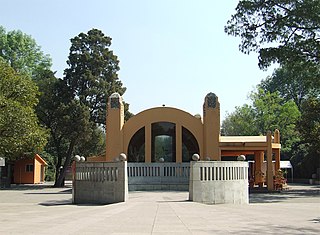
Chapultepec Zoo is a zoo located in Chapultepec Park; it is one of four zoos near Mexico City, and the best known Mexican zoo. It was founded July 6, 1923, by Mexican biologist Alfonso Luis Herrera using donations from private citizens and governmental funds from the Ministry of Agriculture and Development, and also with funds from the Society of Biological Studies.

The Museo de Arte Moderno (MAM) is a museum dedicated to modern Mexican art located in Chapultepec Park in Mexico City.

Guillermo Prieto Pradillo was a Mexican novelist, short-story writer, poet, chronicler, journalist, essayist, patriot and Liberal politician. According to Eladio Cortés, during his lifetime he was considered Mexico's national poet, and his political allegiance to the Mexican liberals allowed him to serve as Minister of Finance and Foreign Affairs under different administrations.
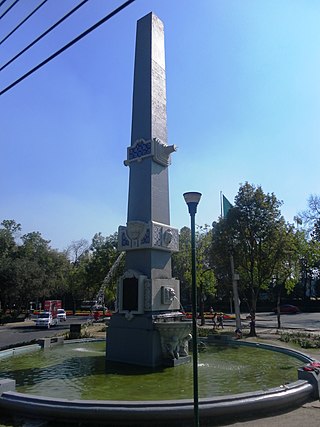
Polanco is a neighborhood in the Miguel Hidalgo borough of Mexico City. Polanco is an affluent colonia, noted for its luxury shopping along Presidente Masaryk Avenue, the most expensive street in Mexico, as well as for the numerous prominent cultural institutions located within the neighborhood.

La Feria de Chapultepec, simply branded as La Feria, was an amusement park in Mexico City, Mexico. Located in the middle of Chapultepec Park near the Constituyentes Metro station, it opened in 1964 as Juegos Mecánicos de Chapultepec and was originally operated by the Mexican government. In 1992 Grupo CIE bought it and changed the name to La Feria Chapultepec Mágico. In 2015, it was bought by Ventura Entertainment and renamed to its last name.
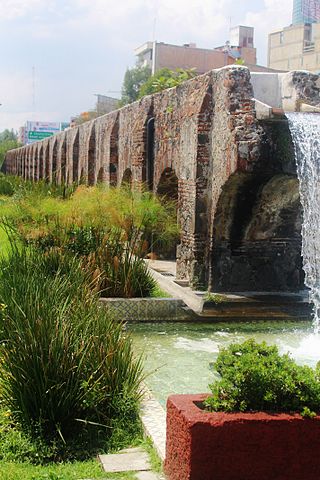
The Chapultepec aqueduct was built to provide potable water to Tenochtitlan, now known as Mexico City. Tenochtitlan was the capital of the Triple Aztec Alliance empire. This fresh water was transported from the Chapultepec springs. Two aqueducts following the same route from the springs were built by the Aztecs during the 15th century, the first destroyed by flooding and the second by the Spanish. After the Spanish conquest a colonial aqueduct was built, the ruins of which are located near Metro Sevilla.
Luis Ortiz Monasterio was a Mexican sculptor noted for his monumental works such as the Monumento a la Madre and the Nezahualcoyotl Fountain in Chapultepec Park. His work was recognized in 1967 with the Premio Nacional de Artes and was a founding member of the Academia de Artes.
Ignacio Asúnsolo (1890–1965) was a Mexican sculptor trained in France.

Chapultepec Uno R509, previously Punto Chapultepec, is a skyscraper in Mexico City at the corner of Paseo de la Reforma and Río Ródano street, immediately west of Torre Mayor. Chapultepec Uno is Mexico City's third tallest building upon completion at 241m and 58 stories high. Part of the tower is occupied by the Ritz Carlton hotel, which was opened on October 28, 2021.
Events in the year 1992 in Mexico.
Events in the year 1964 in Mexico.

The Monumento a los Niños Héroes, officially Altar a la Patria, is a monument installed in the park of Chapultepec in Mexico City, Mexico. It commemorates the Niños Héroes, six mostly teenage military cadets who were killed defending Mexico City from the United States during the Battle of Chapultepec, one of the last major battles of the Mexican–American War, on 13 September 1847.
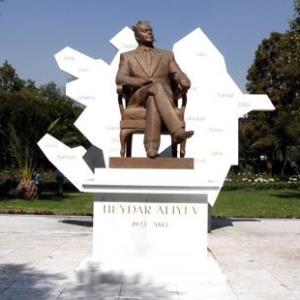
The statue of Heydar Aliyev is a bronze sculpture of the third president of Azerbaijan, Heydar Aliyev, previously installed along Paseo de la Reforma, in Chapultepec, Miguel Hidalgo, Mexico City.














